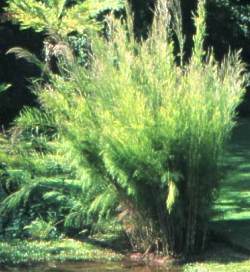Restio paniculatus
Restio paniculatus Rottb.
Family: Restionaceae
Common names: calopsis (English); besemgoed (Afrikaans)
Introduction
This is an attractive waterside plant which is normally found growing in waterlogged soils on river or stream banks.

Description
Description
Restio paniculatus is a tall reed like plant with bright green leaves and stems reaching a height of 3m. It bears clusters of brown grass-like flowers at the terminal ends of the stems. The male and female parts are borne on separate plants, with the female plants bearing small snowy white inflorescences and the male plants bearing less showy inflorescences. The stems arise out of the ground from a strong underground rhizome with the lower parts of the stem looking somewhat bamboo-like.
Distribution and habitat
Distribution description
It is widespread, occurring from the south western Cape through the wetter areas along the seaboard into KwaZulu-Natal.
Derivation of name and historical aspects
History
This plant was formerly known as Calopsis paniculata. The family name name Restionaceae refers to the Latin restis, which means cord or rope and alludes to the use of the plants in southern Africa. The specific name paniculatus means a tuft.
Restios are somewhat similar in appearance, although not related, to the grasses. The fact that Restionaceae are often diocecious (separate male and female plants) can be confusing as the males and female plants may look like totally different species.
Ecology
Ecology
As is the case with most restios, R. paniculatus is wind pollinated, relying on the wind to carry the pollen from the male to the female plant. It is therefore necessary to plant several specimens reasonably close together if you wish to harvest seed.
Uses
Use
R. paniculatus is often used for the making of brooms in the Eastern Cape province as it has shorter branches and more wiry stems than many of the other Cape reeds, which are more often used for thatching.
Growing Restio paniculatus
Grow
It is most attractive when used either fresh or dried in flower arrangements and in the garden forms a wonderful lush green backdrop to a water garden. R. paniculatus can tolerate a moderate degree of frost and enjoys being planted in full sun with its roots in water. Care should be taken when transplanting young plants out of the bag into the garden as undue disturbance and especially root desiccation can be fatal.
Plants may be propagated from seed which can be sown in spring or autumn . The seed needs to be sown on a fine sandy medium and kept consistently moist throughout the germination period. Seed germination can be increased by the use of watering with water treated with smoke treated paper which stimulates germination.
References
- Arnold, T.H. & De Wet, B.C. (Eds) 1993. Plants of southern Africa: names and distribution. Memoirs of the botanical Survey of South Africa No 62. National Botanical Institute: Pretoria.
- Brown, N., Jamieson, H. & Botha, P. 1998. Grow Restios. Kirstenbosch Gardening Series. National Botanical Institute : Cape Town.
- Dorrat-Haaksma,E.& Linder, H.P. 2000. Restios of the Fynbos. Botanical Society of South Africa: Cape Town.
- Jackson. W.P. U. 1990. Origins and meanings of names of South African plant genera.UCT Ecolab: Capetown.
- Stern, W.T. 1983. Botanical Latin - New edition. David & Charles inc. : USA.
Credits
Andrew Hankey
Walter Sisulu National Botanical Garden
February 2002
Plant Attributes:
Plant Type: Restio
SA Distribution: Eastern Cape, KwaZulu-Natal, Western Cape
Soil type: Sandy, Clay, Loam
Flowering season: Sporadic/All year
PH: Neutral
Flower colour: Brown
Aspect: Full Sun
Gardening skill: Easy
Special Features:
Horticultural zones











Rate this article
Article well written and informative
Rate this plant
Is this an interesting plant?
Login to add your Comment
Back to topNot registered yet? Click here to register.